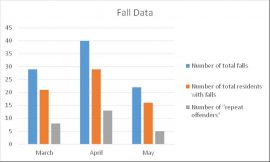 After noticing a recent increase in falls and fall-related injuries at our building, we wanted to better understand the mechanisms of the falls and implement a comprehensive, interdisciplinary fall prevention program.
After noticing a recent increase in falls and fall-related injuries at our building, we wanted to better understand the mechanisms of the falls and implement a comprehensive, interdisciplinary fall prevention program.
Consider the following data:
- March 2016: 29 falls, 21 residents, eight repeat offenders*
- April 2016: 40 falls, 29 residents, 13 repeat offenders*
*Repeat offenders refers to residents who sustained more than one fall in a one-month span
What is the Falling Leaf Program?
This program was developed by Carolyn Spradlin as an adaptation to the Falling Star Program. The identified problem with the Falling Star Program is that it identifies patients at any risk of falls and results in a large number of patients in the program, thus decreasing the effectiveness.
In contrast, the Falling Leaf Program identifies the residents who are at the highest risk of falls. The program works to monitor these specific residents and determine the underlying reasons for these falls. A visual symbol of a leaf is placed outside the patient’s door and is used as a way for team members to intervene more quickly and better meet their needs.
How is it implemented:
- Spacing out Falling Leaf residents among CNAs
- Reassessment of residents on effectiveness of interventions
- Nursing staff identified causes of falls: toileting needs, ADL routines, timing of medications, environmental hazards, etc.
- Visual symbol means all staff members check in on resident when passing the room to make sure all needs have been met
Initial Findings
- Over 50 percent of falls during PM/NOC shifts
- Majority of falls related to toileting needs and unsupervised transfers
- Many falls occur within first week of admission
- 28/99 residents were identified as “high risk” and placed on the Falling Leaf Program in beginning of May
Results After One Month of Program 
- May 2016: 22 falls, 16 residents, five repeat offenders. After one month of implementation, there was a decrease in the number of falls, number of residents falling and number of repeat offenders.
- Of the 22 falls in May, 14 were sustained by Falling Leaf Program participants, indicating a need for further interventions in this population.
- Only three Falling Leaf Program participants had more than one fall in May, demonstrating some effectiveness of our program in decreasing the number of falls of these “high risk” individuals.
Conclusion
The implementation of this program at our facility is still in its early stages as we continue to work out any issues that arise. Some of our initial future plans include weekly reviews to assess for residents who can be removed from the program as well as any additional identified high-fall-risk residents who need to be added to the program. Additionally, we have recently started involving our pharmacy representative in fall meetings to assist with medication reviews to further decrease potential falls.
By Nicole Veniegas, DOR, MS, OTR/L; Kathryn Case, MOT, OTR/L, Magnolia Post Acute Care, El Cajon, CA
View full poster here: Falling Leaf – Magnolia

